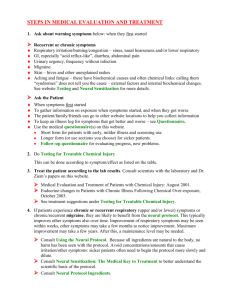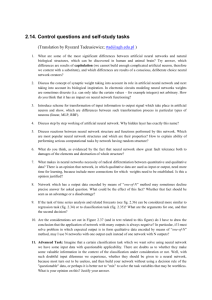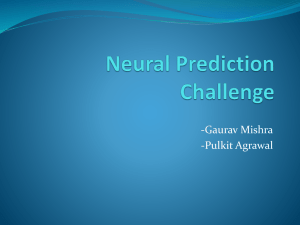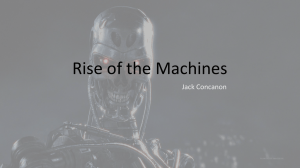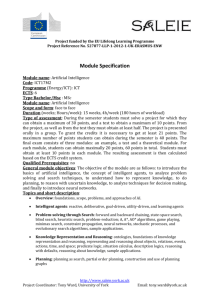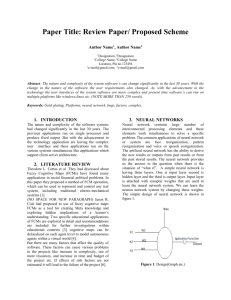New Part #2 of Artificial Intelligence
advertisement
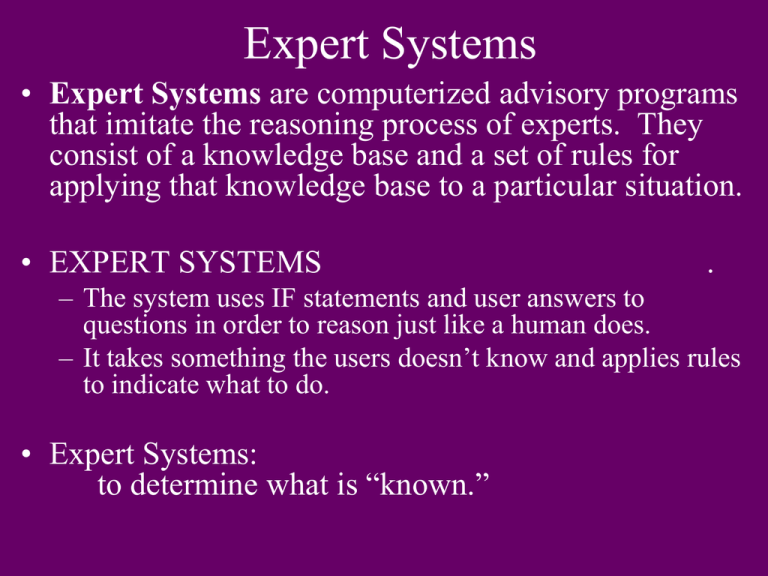
Expert Systems • Expert Systems are computerized advisory programs that imitate the reasoning process of experts. They consist of a knowledge base and a set of rules for applying that knowledge base to a particular situation. • EXPERT SYSTEMS . – The system uses IF statements and user answers to questions in order to reason just like a human does. – It takes something the users doesn’t know and applies rules to indicate what to do. • Expert Systems: to determine what is “known.” Easy Diagnosis Medical Expert System WHAT EXPERT SYSTEMS CAN DO • Can handle massive amounts of information and they can • Can from complex relationships • Can explain their reasoning or suggested decisions • Provide decision making. in • Improve customer service. • Reduce errors and costs. • Provide WHAT EXPERT SYSTEMS CAN’T DO • Handle all types of domain expertise. Human experts might not fully be aware of the process that they use. Can’t put everything into machine form. • Can’t solve problems in areas not designed for. Can’t • Apply or judgment to a problem Expert Systems Perform and Tasks Like • • • • • • Expert System used Auditing and tax planning by American Diagnosing illnesses Express’ Optima Card program. Managing forest resources VB Loan Evaluate credit and loan applications System Computer help desk diagnosis assistance Rules to follow when directing air traffic Smartflow Acquired Intelligence Whale Watcher Douglas Fir Cone and Seed Exsys Corvid Which Dog Breed is best for you? Marathon Race Advisor Albuquerque Restaurant Advisor Web Support Camcorder Selection Ethical Questions and the Use of Expert Systems • An expert system will act as it is programmed. If you program in bias, then the system will be biased. • The expert system is consistent, which is easily defended in court. • Can distinguish between good and bad, but may not be able to distinguish between degrees of good. • Expert Systems are computerized advisory programs that imitate the reasoning process of experts. – EXPERT SYSTEMS apply rules to solve a problem. – Expert Systems: ask a series of questions to determine what is “known.” • Neural Networks mimic the way the brain works, analyzing large quantities of data and information to establish patterns and infer relationships. – They • They can “see” subtle, hidden and newly emerging patterns within large amounts of complex data. A NEURAL NETWORK is an artificial intelligence system which is capable of learning because it’s patterned after the human brain. Uses parallel processors. A neural network simulates the human ability to classify things based on the experience of seeing many examples. Learn by NEURAL NETWORKS • Typically used to combat attempts at fraud • Credit card fraud or insurance fraud. • Able to detect money laundering attempts. • Working in conjunction with X-ray machines, can be used to detect weapons and other forbidden items. • Often used to make investment decisions (stocks, bonds, futures markets, etc.) • Can also detect inefficiencies in financial markets Learn by looking at a data set and finding patterns in it. A Neural Network Can Perform Tasks Like • Distinguishing different chemical compounds • D in human tissue that may signify disease • A to detect forgeries. • De • Track habits of insurance customers and predict which ones might not renew their policies • Virus Detection Software by IBM • Neugent monitors 1,200 data points in the Allstate Insurance network every 5 seconds, trying to predict a potential problem in/with the network. Neural networks attempt to mimic the structure and functioning of the human brain. They contain input, output and hidden layers. The hidden layers use various weights of strength to . As the system , it can change the classification weights. Neural networks can adjust or change themselves over time based upon data input regarding successful and unsuccessful mortgage applications. Neural networks as they “learn”. Expert systems . Neural Networks serve as Systems • Allows the computer to or it receives. • There are computer games with learning abilities. • 20Questions www.20Q.net • F and neural networks are often combined to express complicated and concepts (that are and ambiguous) in a form that makes it possible to simplify the problem and apply rules with some degree of certainty. Fuzzy Logic • Fuzzy Logic: a special field of computer science that and does not require conditions to be • A mathematical method of handling information so that ambiguous information such as “ ” or “ ” or other “non-exact areas usable in computer systems • Applications – – – – – – Google’s search engine (your perception of a topic frames your query) Washing machines that wash until the water is “clean” A and subway/tram control systems A cameras Temperature sensors attached to furnace controls Medical equipment that based upon patient vital signs. • EXPERT SYSTEMS apply rules to solve a problem. – The system uses IF statements and user answers to questions in order to reason just like a human does. – It takes something the users doesn’t know and applies rules to indicate what to do. – Expert Systems: ask a series of questions to determine what is “known.” • NEURAL NETWORKS recognize/learn patterns and can apply that learning to the unknown. – It is either taught by someone or teaches itself. After it is taught to recognize the pattern, it can adjust itself to reflect new learning. – Neural networks: system is “guessing” based upon examples and patterns found in the data set- trying to figure out what category something fits in. • GENETIC ALGORITHMS generate several generations of solutions, with each generation resulting in a better solution to the problem.




